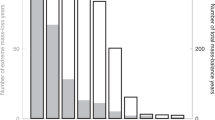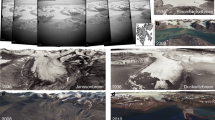Abstract
The near-global retreat of glaciers over the last century provides some of the most iconic imagery for communicating the reality of anthropogenic climate change to the public. Surprisingly, however, there has not been a quantitative foundation for attributing the retreats to climate change, except in the global aggregate. This gap, between public perception and scientific basis, is due to uncertainties in numerical modelling and the short length of glacier mass-balance records. Here we present a method for assessing individual glacier change based on the signal-to-noise ratio, a robust metric that is insensitive to uncertainties in glacier dynamics. Using only meteorological and glacier observations, and the characteristic decadal response time of glaciers, we demonstrate that observed retreats of individual glaciers represent some of the highest signal-to-noise ratios of climate change yet documented. Therefore, in many places, the centennial-scale retreat of the local glaciers does indeed constitute categorical evidence of climate change.
This is a preview of subscription content, access via your institution
Access options
Subscribe to this journal
Receive 12 print issues and online access
$259.00 per year
only $21.58 per issue
Buy this article
- Purchase on Springer Link
- Instant access to full article PDF
Prices may be subject to local taxes which are calculated during checkout




Similar content being viewed by others
References
Nussbaumer, S. U. & Zumbühl, H. J. The little ice age history of the glacier des Bosons (Mont Blonc massif, France): a new high-resolution glacier length curve based on historical documents. Climatic Change 111, 301–334 (2012).
Forbes, J. D. Occasional Papers on the Theory of Glaciers (A & C Black, 1859).
Tyndall, J. & Huxley, T. H. Observations on Glaciers. Proc. R. Soc. Lond. 8, 331–338 (1857).
Solomina, O. N. et al. Holocene glacier fluctuations. Quat. Sci. Rev. 111, 9–34 (2015).
Leclercq, P. W. et al. A data set of world-wide glacier length fluctuations. Cryosphere 8, 659–672 (2014).
Braithwaite, R. J. & Zhang, Y. Relationships between interannual variability of glacier mass balance and climate. J. Glaciol. 45, 456–462 (1999).
Medwedeff, W. G. & Roe, G. H. Trends and variability in the global dataset of glacier mass balance. Clim. Dynam. http://dx.doi.org/10.1007/s00382-016-3253-x (2016).
Oerlemans, J. Holocene glacier fluctuations: is the current rate of retreat exceptional? Ann. Glaciol. 31, 39–44 (2000).
Marzeion, B., Cogley, J. G., Richter, K. & Parkes, D. Attribution of global glacier mass loss to anthropogenic and natural causes. Science 345, 919–921 (2014).
Leclercq, P. W. & Oerlemans, J. Global and hemispheric temperature reconstruction from glacier length fluctuations. Clim. Dynam. 38, 1065–1079 (2012).
Bindoff, N. L. et al. in Climate Change 2013: The Physical Science Basis (eds Stocker, T. F. et al.) Ch. 10 (IPCC, Cambridge Univ. Press, 2013).
Jóhannesson, T., Raymond, C. F. & Waddington, E. D. Timescale for adjustments of glaciers to changes in mass balance. J. Glaciol. 35, 355–369 (1989).
Oerlemans, J. Glaciers and Climate Change (A. A. Balkema, 2000).
Roe, G. H. & Baker, M. B. Glacier response to climate perturbations: an accurate linear geometric model. J. Glaciol. 60, 670–684 (2014).
Anderson, L. S., Roe, G. H. & Anderson, R. S. The effects of interannual climate variability on paleoclimate estimates derived from glacial moraines. Geology 42, 55–58 (2014).
Rohde, R. et al. A new estimate of the average earth surface land temperature spanning 1753 to 2011. Geoinfor. Geostat. http://dx.doi.org/10.4172/gigs.1000101 (2013).
Legates, D. R. & Willmott, C. J. Mean seasonal and spatial variability in gauge corrected global precipitation. Int. J. Climatol. 10, 111–127 (1990).
Fluctuations of Glaciers Database (World Glacier Monitoring Service (2014); http://dx.doi.org/10.5904/wgms-fog-2014-09
Greuell, W. Hintereisferner, Austria: mass-balance reconstruction and numerical modelling of the historical length variations. J. Glaciol. 38, 233–244 (1992).
Annan, J. D. & Hargreaves, J. C. Using multiple observationally-based constraints to estimate climate sensitivity. Geophys. Res. Lett. 33, L06704 (2006).
Matthews, J. A. & Briffa, K. R. The little ice age: re-evaluation of an evolving concept. Geogr. Ann. 87 A, 17–36 (2005).
Nadarajah, S. & Kotz, S. Computation of signal-to-noise ratios. Commun. Math. Comput. Chem. 57, 105–110 (2007).
von Storch, H. & Zwiers, F. W. Statistical Analysis in Climate Research (Cambridge Univ. Press, 1999).
Roe, G. H. What do glaciers tell us about climate variability and climate change? J. Glaciol. 57, 567–578 (2011).
Schneider, T. & Neumaier, A. Algorithm 808: ARFIT—a Matlab package for the estimation of parameters and eigenmodes of multivariate autoregressive models. ACM Trans. Math. Softw. 27, 58–65 (2001).
Burke, E. E. & Roe, G. H. The persistence of memory in the climatic forcing of glaciers. Clim. Dynam. 42, 1335–1346 (2014).
Acknowledgements
We are grateful to P. Green, K. Armour, D. Battisti and E. Steig for valuable comments and conversations. F.H. thanks the Institute of Atmospheric and Cryospheric Sciences, University of Innsbruck for financial support.
Author information
Authors and Affiliations
Contributions
G.H.R., M.B.B. and F.H. planned the analyses, which G.H.R. performed. All authors contributed to the interpretation of the results and to writing the manuscript.
Corresponding author
Ethics declarations
Competing interests
The authors declare no competing financial interests.
Supplementary information
Supplementary Information
Supplementary Information (PDF 3332 kb)
Supplementary Information
Supplementary Information (XLSX 64 kb)
Rights and permissions
About this article
Cite this article
Roe, G., Baker, M. & Herla, F. Centennial glacier retreat as categorical evidence of regional climate change. Nature Geosci 10, 95–99 (2017). https://doi.org/10.1038/ngeo2863
Received:
Accepted:
Published:
Issue Date:
DOI: https://doi.org/10.1038/ngeo2863
This article is cited by
-
The effect of climate change on sources of radionuclides to the marine environment
Communications Earth & Environment (2024)
-
Anthropogenic impacts on mud and organic carbon cycling
Nature Geoscience (2024)
-
Glacier retreat triggers changes in biodiversity and plant–pollinator interaction diversity
Alpine Botany (2024)
-
Greenland-wide accelerated retreat of peripheral glaciers in the twenty-first century
Nature Climate Change (2023)
-
Glacial lake outburst floods threaten millions globally
Nature Communications (2023)



